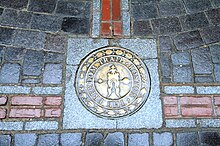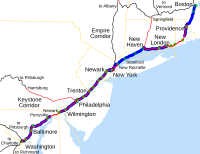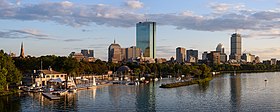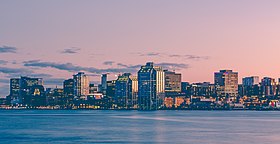Atlantic Northeast
This article mayrequirecleanupto meet Wikipedia'squality standards.The specific problem is:Writing style needs improvement, and several sections need further fact checking.(February 2021) |
Atlantic Northeast | |
|---|---|
|
Left-right from top:Bostonskyline,Bass Harbor Head Light,Western Brook Pond,Montrealskyline,Fundy National Park,Mount Washington,Halifaxskyline | |
| Nickname: Atlantica | |
 | |
| Countries | CanadaandUnited States |
| States/Provinces | |
| Territories |
|
| Largest metropolitan areas | |
| Languages | Englishdialects Frenchdialects Other languages |
TheAtlantic Northeast(French:Atlantique nord-est) is a geographic and cultural region of easternNorth Americabounded by theAtlantic Oceanto the east and (loosely) by theSaint Lawrence Riverto the northwest. Though no official boundary exists, the most common conception includes theMaritime provinces,southernQuebec,and the island ofNewfoundlandinCanada,and theNew Englandregion of theUnited States.Broader conceptions reach further north into Canada, includingLabradorand theCôte-Nordregion of Quebec. Narrower conceptions may be limited to the coastal areas east of theAppalachian Mountains.The variety of definitions can be attributed to overlapping commonalities of the region's history, culture, geography, ecology, society, and other factors.
Definition
[edit]The term "Atlantic Northeast" should not be confused withAtlantic Canada,which includes the entirety ofNew Brunswick,Newfoundland and Labrador,Nova Scotia,andPrince Edward Island,but excludesQuebec.It should also not be confused with the northeastern portion of theAtlantic Ocean.
History
[edit]The predominant nations in the region over the course of the estimated last 11,000 years have been theAbenaki,Penobscot,Mi'kmaq,Maliseet,andPassamaquoddy,all of whom were later associated with theWabanaki Confederacy.[1]These nations'countriesmainly overlapped the soon-to-beMaritime provinces,such asMi'kma'kiand Wolastokuk withNew Brunswick,Nova Scotia,andPrince Edward Island,as well as Ndakinna, Peskotomuhkatik, and Pαnawαhpskewahki withVermont,New Hampshire,andMassachusetts.
Before 1620 the conflicts between First Nations and English settlers started due to the alienation of tribes; they also kidnapped members of the tribes through violence.[2]The violence confused many Indigenous nations because they also traded with proper settlers, but this left the First Nations resentful of the European nations.[2]The presence of the French and English in the Atlantic Northeast attracted theDutchto begin trading on theHudson Riverwith different peoples. The new presence of these traders also brought unwanted microbes, viruses, and bacteria that took a disastrous toll on the Indigenous populations.[1]Whensmallpoxswept the New England area in 1610, the native population hit an all-time low, since they were trying to fight off a virus that was not indigenous to the area.[3]Eventually the population recovered but not completely. After the outbreak settlers became highly interested in the Wabanaki beaver pelts, which they would trade for glass, metal, and weapons.[4]
During the period of theexpulsion of the Acadians,thousands were deported from the present-day Canadian provinces of Nova Scotia, New Brunswick, and PEI, as well as from northern Maine — parts of the French region calledAcadie— into theThirteen Colonies,from 1755 until 1758. Large parts of Nova Scotia were subsequently resettled by new arrivals from New England before 1775.[5]At the end of theAmerican Revolution,nearly 75,000Loyalistsresettled in Nova Scotia, New Brunswick and Québec. Close to 3,500 freeAfrican Americanswent to Nova Scotia. Before 1860, about 30,000–40,000 black people entered Canada, many of them joining the previous group in Nova Scotia, either free or as escaped slaves through theUnderground Railroad.[6]From the mid-19th century until theGreat Depressionin the 1930s, nearly 900,000French Canadiansemigrated from Québec to the U.S. Two-thirds went into New Englandmill towns.[7]
Geography
[edit]Major geographical features of the Atlantic Northeast include theAppalachian Mountains,theGreen Mountains,theAtlantic Ocean,Long Island Sound,theGulf of Maine,theGulf of Saint Lawrence,theBay of Fundy,theMerrimack River,theBoston Harbor,theTaunton River,theBlackstone River,theConnecticut River,theHousatonic River,and theHoosic River.[8]
Border disputes
[edit]The "Gray Zone" is an area of land and sea which is claimed by both Canada and the United States. It is located off the coasts ofNew BrunswickandMaine.The only land within this area are two islands,Machias Seal IslandandNorth Rock.The "Gray Zone" is one offour areas between the two countries whose sovereignty is still in dispute,but is the only one of the disputed areas containing land. In 1979, both countries filed a joint application to theInternational Court of Justiceto avoid having the dispute settled when oceanic boundaries in the area were set for mineral and fishing rights. Canadians have had a continuous presence in the area since 1832 when a lighthouse was built.[9][10]
Places of interest
[edit]
Northeast Canyons and Seamounts Marine National Monumentis located 150 miles (240 km) off the shore ofCape Cod.The national monument comprises 4,900 square miles (13,000 km2) of underwater canyons carved into thecontinental shelf,and has an underwater mountain rising 7,000 feet (2,100 m) above the ocean floor. This monument is home to many marine species, fish, whales, and dolphins. The monument was formed by a declaration by PresidentBarack Obama.[11]
Salem, Massachusetts,is a famous location in New England known primarily for theSalem witch trials.It was also one of Massachusetts' wealthiest ports for trading in the late 18th century.[8]
Acadia National Parkis onMount Desert Islandin Maine, with 47,000 acres (19,000 ha) of woodlands, rocky shoreline, trails, camping, and wildlife. The park is home toCadillac Mountain,the highest mountain on the east coast of the United States.[12]
Climate
[edit]The Atlantic Northeast region has a four-seasonclimate. In theNew Englandregion of the United States, summers are hot with an average temperature of 80–85 °F (27–29 °C) in late June through August. In the fall the air is cool, with temperatures from 45 to 50 °F (7 to 10 °C), and in the spring it tends to be rainy, with temperatures from 40 to 60 °F (4 to 16 °C). In the winter there tends to be a lot of snowfall averaging around 35 inches (890 mm) per year. The typical temperature in this area during the winter is around 25 °F (−4 °C).[13]TheCanadian Maritimeshave seasons very similar to the New England areas.New Brunswickhas cold winters ranging from approximately 19–31 °F (−7 – −1 °C) and hot summers with temperatures from 72 to 77 °F (22 to 25 °C).Prince Edward Islandhas a climate similar to New Brunswick with temperatures ranging from 46 to 71 °F (8 to 22 °C) in the summer and 11 to 26 °F (−12 to −3 °C) in the winter.[14]In the summer inNova Scotiatemperatures will reach around 75 °F (24 °C), and in the winter temperatures will drop as low as 24 °F (−4 °C).[15]
Demographics
[edit]Most of the region's population is concentrated in southwesternNew Englandand theSaint Lawrence Lowlandsof Quebec, both of which form the northern part of their respective country's largestmegalopolises.The region's largest metropolitan areas areGreater Boston,Massachusetts,with 4.8 million people;[16]Greater Montreal,Quebec, with 4.1 million people;[17]Greater Providence,Rhode Island,with 1.62 million people;[18]andGreater Hartford,Connecticut,with 1.21 million people.[19]
Largest cities and metropolitan areas
[edit]This is a list of the most populous cities and metropolitan areas in the Atlantic Northeast based on the2016 Canadian census[20][21]andUnited States Census Bureaupopulation estimates as of July 1, 2019.[22][23][24][25]
| City | State/Province | Population | Metropolitan area |
|---|---|---|---|
| Montreal | Quebec | 1,704,694 | 4,098,927 |
| Boston | Massachusetts | 692,600 | 4,875,390 |
| Quebec City | Quebec | 531,902 | 800,296 |
| Laval | Quebec | 422,993 | [n 1] |
| Halifax | Nova Scotia | 316,701 | 403,131 |
| Longueuil | Quebec | 239,700 | [n 1] |
| Worcester | Massachusetts | 185,428 | 923,672 |
| Providence | Rhode Island | 179,883 | 1,609,359 |
| St. John's | Newfoundland and Labrador | 178,427 | 205,955 |
| Sherbrooke | Quebec | 161,323 | 212,105 |
| Springfield | Massachusetts | 153,606 | 692,942 |
| Saguenay | Quebec | 145,949 | 160,980 |
| Bridgeport | Connecticut | 144,399 | 939,904 |
| Lévis | Quebec | 143,414 | [n 2] |
| Trois-Rivières | Quebec | 134,413 | 156,042 |
| New Haven | Connecticut | 130,250 | 862,477 |
| Stamford | Connecticut | 129,638 | [n 3] |
| Hartford | Connecticut | 122,105 | 1,214,295 |
| Cambridge | Massachusetts | 118,927 | [n 4] |
| Manchester | New Hampshire | 112,673 | 406,678 |
| Terrebonne | Quebec | 111,575 | [n 1] |
| Lowell | Massachusetts | 110,997 | [n 4] |
| Moncton | New Brunswick | 108,620 | 144,810 |
| Waterbury | Connecticut | 107,568 | [n 5] |
Notes
[edit]- ^abcPart ofGreater Montreal.
- ^Part of theCommunauté métropolitaine de Québec.
- ^Part ofGreater Bridgeport.
- ^abPart ofGreater Boston.
- ^Part ofGreater New Haven.
Culture
[edit]Sports
[edit]| New England Patriots | New England Revolution | Boston Celtics | Boston Bruins | Boston Red Sox | Halifax Hurricanes | Montreal Canadiens | |
|---|---|---|---|---|---|---|---|
| Home stadium | Gillette Stadium | Gillette Stadium | TD Garden | TD Garden | Fenway Park | Scotiabank Centre | Bell Centre |
| Home location | Foxboro, Massachusetts | Foxboro, Massachusetts | Boston, Massachusetts | Boston, Massachusetts | Boston, Massachusetts | Halifax, Nova Scotia | Montreal, Québec |
| Championships won | 6 | 1 | 17 | 6 | 9 | 1 | 24 |
| Sports league | National Football League | Major League Soccer | National Basketball Association | National Hockey League | Major League Baseball | National Basketball League | National Hockey League |
| Year established | 1960 | 1995 | 1946 | 1924 | 1901 | 2007 | 1909 |
Historical landmarks
[edit]Alexander Graham Bell National Historic SiteinBaddeck,Cape Breton Island,Nova Scotia, commemoratesAlexander Graham Bell,a remarkable inventor who created Canada's first engine-powered airplane, the world's fastest boat, and the world's first telephone, along with many other achievements.[28]

Halifax Citadel National Historic Siteis the site of Fort George in Halifax, Nova Scotia. Visitors can take tours of the fort, learning about its soldiers, its legends and ghost stories, and even become a soldier for the day.[29]
TheFreedom Trailis a two and a half mile walking trail through the city of Boston that takes visitors past sixteen historic sites that led to the American Revolution, including theBoston Common,thePark Street Church,theGranary Burying Ground,King's Chapel,theOld Corner Bookstore,theOld State House,the site of theBoston Massacre,Faneuil Hall,thePaul Revere House,theOld North Church,theUSSConstitution,and theBunker Hill Monument.[30]
TheSalem Witch Museumdescribes the history of theSalem witch trialsof 1692 through life-size figures and narrations.[30]
TheFirst Baptist Church in Americawas founded inProvidence, Rhode Island,in 1638 byWilliam Vincent CarpenterandRoger Williamsand was later rebuilt in 1774. Guided tours are available from Memorial Day through Labor Day on weekdays, and self tours of the landmark are available all year round.[30]
TheLake Champlain Maritime Museum,inVergennes, Vermont,open from May to October, houses historicschooners,steamboats,wooden boats,shipwrecks,and even a Revolutionary War gunboat replica. Visitors can learn about the history of the lake's role in commerce, communication, transportation, and war, as well as its natural history above and below sea level.[30]
Charlottetown City Hallis the oldest municipal building on Prince Edward Island, built in 1888. Visitors can tour the City Hall to learn about the history and present day of Prince Edward Island and the city ofCharlottetown.[31]
Transportation
[edit]This sectionneeds expansion.You can help byadding to it.(August 2021) |

Wildlife
[edit]Birds
[edit]
In the Atlantic Northeast it is common to see many birds living in the region, includingbald eagles(Haliaeetus leucocephalus),piping plovers(Atlantic coast) (Charadrius melodus), thered-cockaded woodpecker(Picoides borealis), thered knot(Calidris canutus rufa), the North American subspecies of theroseate tern(Sterna dougallii dougallii), andshorebirds.[32]
Aquatic life
[edit]
The aquatic life in the Atlantic Northeast is quite extensive. The more common animals that are found in the area include theAmerican eel(Anguilla rostrata), Appalachian monkey-face pearly mussel (Theliderma sparsa),dwarf wedgemussel(Alasmidonta heterodon),Atlantic horseshoe crab(Limulus polyphemus), Kenk's amphipod (Stygobromus kenki), andnorthern red-bellied cooter(Pseudemys rubriventris).[33][failed verification]
Plants
[edit]
The plant life in the Atlantic Northeast is quite varied due to the turbulent climate in that area, but some of the more common plant life includes such species as Furbish lousewort (Pedicularis furbishiae),Jesup's milk-vetch(Astragalus robbinsiivar. jesupii), and Northeastern bulrush (Scirpus ancistrochaetus).[34][failed verification]
See also
[edit]- Acadia
- Northeastern United States
- The Maritimes
- New England
- Atlantic Canada
- New England Governors and Eastern Canadian Premiers' Annual Conference
References
[edit]- ^abHoxie, Frederick (2016).The Oxford Handbook of American Indian History.Oxford University Press.ISBN9780199858897.
- ^abHoxie, F.E. (2016).The Oxford Handbook of American Indian History.Oxford Handbooks. Oxford University Press. p. 340.ISBN978-0-19-061402-7.RetrievedFebruary 19,2023.
- ^Pestana, C.G. (2015).Inequality in Early America.Reencounters with Colonialism: New Perspectives on the Americas. Dartmouth College Press. p. 114.ISBN978-1-61168-692-0.RetrievedFebruary 19,2023.
- ^American Friends Service Committee (1989).The Wabanakis of Maine and the Maritimes: A Resource Book about Penobscot, Passamaquoddy, Maliseet, Micmac and Abenaki Indians; with Lesson Plans for Grades 4 Through 8.The Program. p. 21.
- ^John Brebner,The Neutral Yankees of Nova Scotia: A Marginal Colony During the Revolutionary Years(1937)
- ^Patrick Bode, "Upper Canada, 1793: Simcoe and the Slaves,"Beaver1993 73(3): 17–19; Paul Robert Magocsi, ed.Encyclopedia of Canada's Peoples(1999) p 142–3
- ^David Vermette,A Distinct Alien Race: The Untold Story of Franco-Americans: Industrialization, Immigration, Religious Strife(2018)
- ^ab"Discover New England".Discover New England.org.Nancy Marshall Communications. Archived fromthe originalon November 15, 2016.RetrievedNovember 15,2016.
- ^"The Border Isn't As Clear As You Think".The Huffington Post.December 23, 2012.RetrievedNovember 15,2016.
- ^"U.S.-Canada Border: History, Disputes & More".Sovereign Limits.October 30, 2018.RetrievedJune 2,2022.
- ^"Letter-writers make history: President Obama declares first Atlantic Ocean National Monument".National Geographic.Archived fromthe originalon September 23, 2016.
- ^"The First Eastern National Park".NPS.gov.American government.
- ^"Facts About New England, USA | Discover New England".www.discovernewengland.org.Archived fromthe originalon November 15, 2016.RetrievedNovember 15,2016.
- ^Canada, Province of Prince Edward Island."Government of PEI: What's the weather like?".www.gov.pe.ca.RetrievedNovember 15,2016.
- ^"Average Temperature in Nova Scotia".RetrievedNovember 15,2016.
- ^"County Population Totals and Components of Change: 2010-2018".United States Census Bureau.RetrievedOctober 4,2019.
- ^"Population and dwelling counts, for census metropolitan areas, 2016 and 2011 censuses – 100% data".Statistics Canada.Government of Canada. February 8, 2017.Archivedfrom the original on February 11, 2017.RetrievedFebruary 14,2017.
- ^"Annual Estimates of the Resident Population: April 1, 2010 to July 1, 2019".United States Census Bureau. April 2, 2020.RetrievedApril 27,2020.
- ^"2019 U.S. Gazetteer Files".United States Census Bureau.RetrievedJuly 2,2020.
- ^"Population counts, for census metropolitan areas, census agglomerations, population centres and rural areas, 2016 Census".Statistics Canada. February 8, 2017.RetrievedFebruary 8,2017.
- ^"Population and dwelling counts, for Canada, provinces and territories, census metropolitan areas and census agglomerations, 2016 and 2011 censuses – 100% data".Statistics Canada. February 8, 2017.RetrievedFebruary 8,2017.
- ^"Connecticut Subcounty Resident Population Estimates: April 1, 2010 to July 1, 2019".U.S. Census Bureau.RetrievedJuly 24,2020.
- ^"Massachusetts Subcounty Resident Population Estimates: April 1, 2010 to July 1, 2019".U.S. Census Bureau.RetrievedJuly 24,2020.
- ^"New Hampshire Subcounty Resident Population Estimates: April 1, 2010 to July 1, 2019".U.S. Census Bureau.RetrievedJuly 24,2020.
- ^"Rhode Island Subcounty Resident Population Estimates: April 1, 2010 to July 1, 2019".U.S. Census Bureau.RetrievedJuly 24,2020.
- ^"Massachusetts Sports Teams | Boston Sports Teams".RetrievedNovember 15,2016.
- ^"Home".www.halifaxhurricanes.ca.Archived fromthe originalon July 19, 2017.RetrievedNovember 15,2016.
- ^"Alexander Graham Bell National Historic Site".Tourism Nova Scotia.RetrievedNovember 15,2016.
- ^"Halifax Citadel National Historic Site".Tourism Nova Scotia.RetrievedNovember 15,2016.
- ^abcd"Colonial New England | Tours of Cities, Parks, Museums, Architecture".www.visitnewengland.com.RetrievedNovember 15,2016.
- ^"Discover Charlottetown - See map".www.discovercharlottetown.com.Archived fromthe originalon April 27, 2017.RetrievedNovember 16,2016.
- ^"North Atlantic - Appalachian Region".Northeast Region, U.S. Fish and Wildlife Service. December 7, 2020.
- ^"Energy and Environmental affairs".Mass.gov.Massachusetts Division of Fisheries and Wildlife.
- ^"Energy and Environmental Affairs".Mass.gov.American government.
- Geography of New England
- Geography of the Maritimes
- Regions of the United States
- Geography of Connecticut
- Geography of New Hampshire
- Geography of New York (state)
- Geography of Rhode Island
- Geography of Vermont
- Geography of Maine
- Geography of Quebec
- Geography of Nova Scotia
- Geography of New Brunswick
- Geography of Prince Edward Island
- Geography of Newfoundland and Labrador







